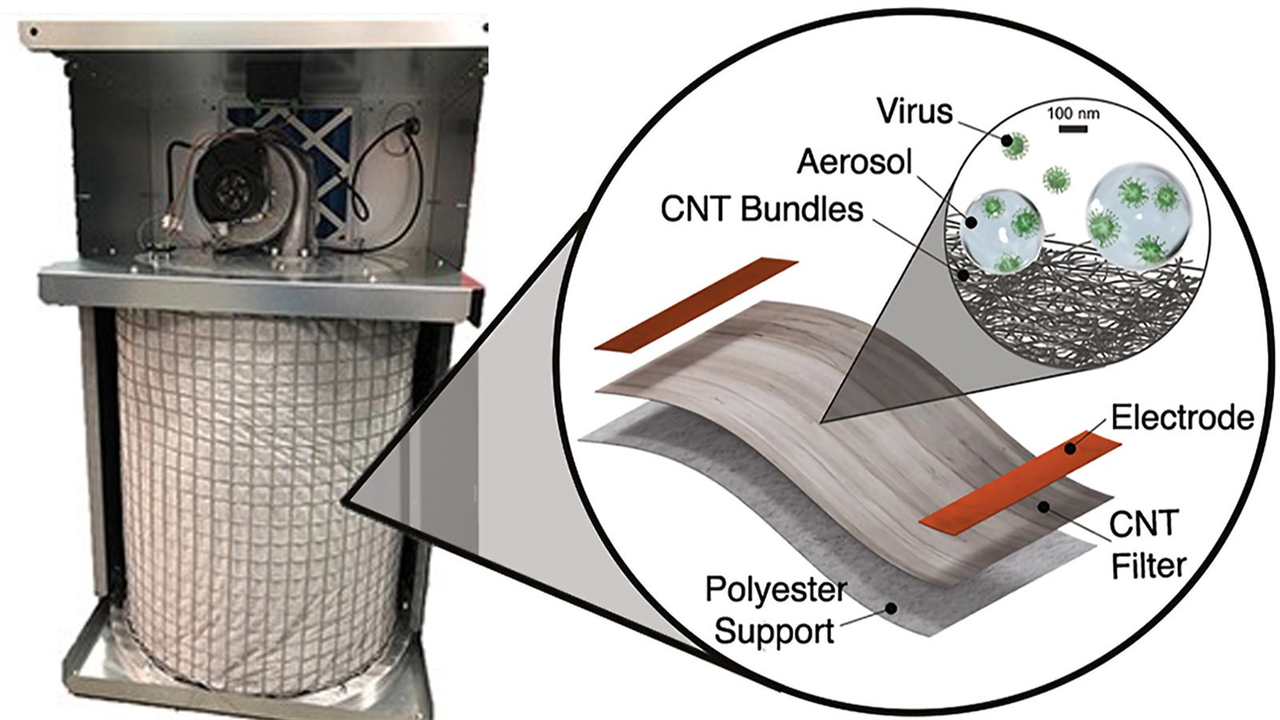“Virus-Killing” Air Filtration System Unveiled – Innovative Nanomaterial Destroys Viruses, Including Coronaviruses
0 View
Share this Video
- Publish Date:
- 7 November, 2021
- Category:
- Covid
- Video License
- Standard License
- Imported From:
- Youtube
Tags

Credit: University of Cambridge
Cambridge scientists and engineers have developed a new carbon-based nanomaterial for air filtration that can trap and destroy several viruses, including animal coronavirus, a close relative of SARS-CoV-2 – the virus that causes COVID-19.
The prototype, which was worked on and tested by a multidisciplinary team of researchers from the Boies Group, in the Department of Engineering, and with colleagues from the Department of Materials Science & Metallurgy and Department of Pathology, is equipped with ultra-thin carbon nanotubes that are electrically conductive. membranes. This new conductive filtration membrane enables simultaneous virus filtration and decontamination by thermal flashes via resistive heating to temperatures above 100°C, deactivating viruses, including betacoronavirus, in seconds.
The researchers say the multi-purpose filter is especially helpful in combating the viral spread of airborne diseases in confined environments such as emergency vehicles, hospitals, leisure and education centers, whether used as a stand-alone unit or in combination. with heating, ventilation and air conditioning (HVAC) filtration systems. The results, including findings taken during virus infectivity trials, supported by theoretical modeling, are reported in the journal Carbon.
The filter represents a new class of conductive filtration media that enables electrical functionality with the ability to be mass-produced, and with a filtration efficiency and air permeability equivalent to commercial high-efficiency particulate air (HEPA) filters. It effectively traps droplets of respiratory fluids – a carrier of many viruses, including coronaviruses – produced by coughing, speaking and breathing that float in the air for hours and migrate tens of meters in confined environments. It is these respiratory particles that contribute to high infection rates in closed and crowded spaces.
The innovative carbon nanotube material, produced by a unique process invented at the university, is also the pillar of the ANAM initiative, funded by the EPSRC, which aims to unlock the commercial potential of carbon nanotubes.
PhD student Liron Issman said: “Based on the knowledge gained through this project (the result of an Innovate UK funded grant), several working prototypes have been developed demonstrating that the filter is capable of filtering 99% of a small space. or an ambulance within 10-20 minutes Several industry collaboration projects have been launched with leading air filtration companies to introduce this carbon nanotube material into state-of-the-art applications to help combat COVID-19 and other airborne pathogens.
“To meet market demand, our unique process is being scaled up commercially by Q-Flo Limited, a University of Cambridge spin-out, to initially produce more than 100,000 m²/year of membrane material. The advantages of these conductive filtration materials are that they offer low flow resistance with high capture efficiency and additional heating and sensing capabilities.”
Reference: “Filtration of Viral Aerosols through a Hybrid Carbon Nanotube Active Filter” by Liron Issman, Brian Graves, Jeronimo Terrones, Myra Hosmillo, Rulan Qiao, Michael Glerum, Shuki Yeshurun, Martin Pick, Ian Goodfellow, James Elliott and Adam Boies, 6 July 2021, Carbon.
DOI: 10.116/j.carbon.2021.07.004










